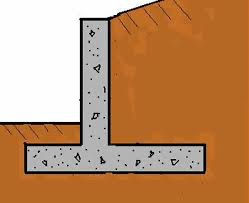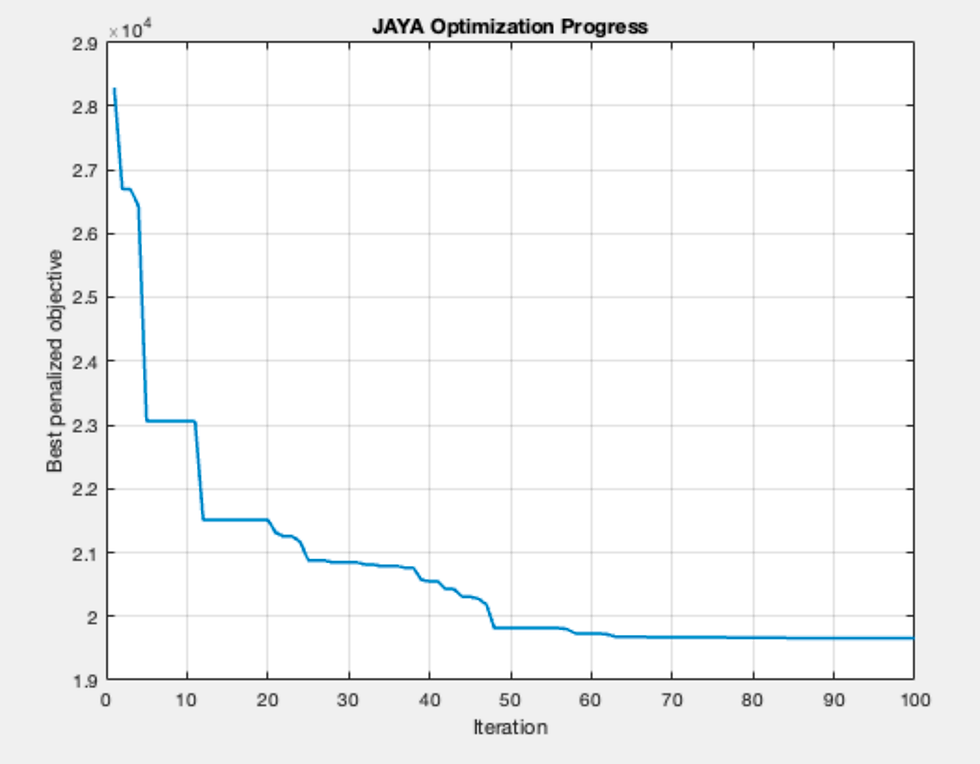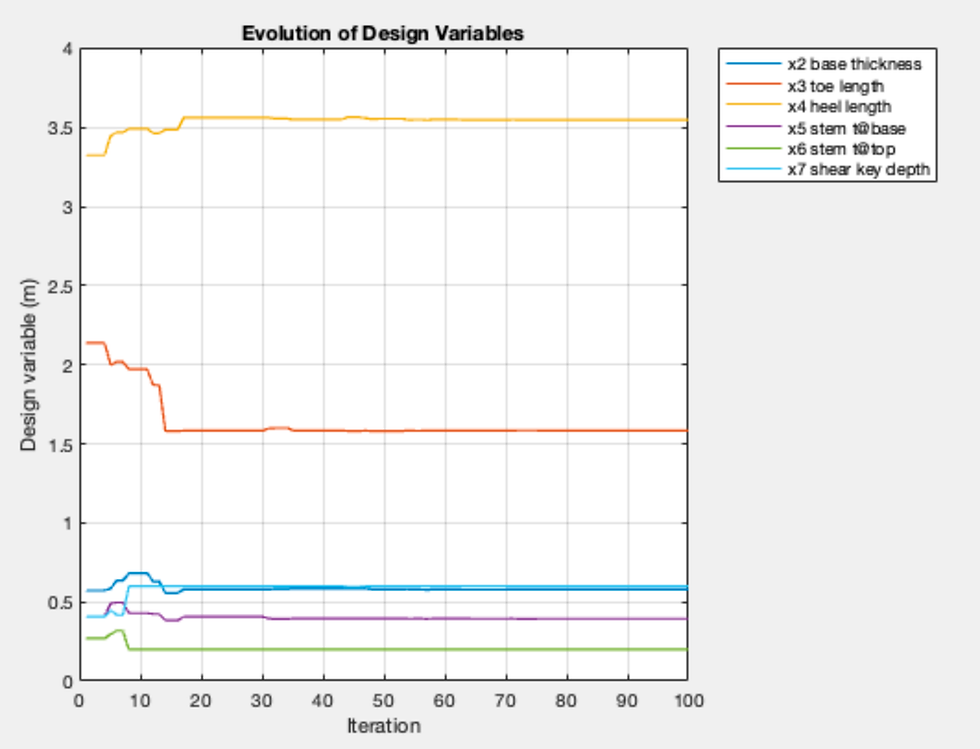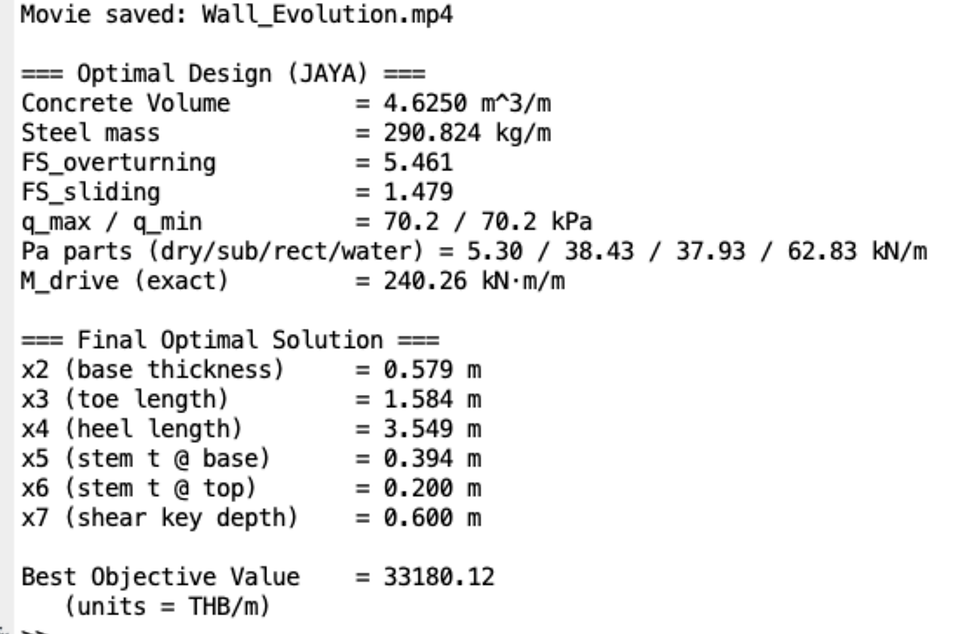Optimized Cantilever Retaining Wall Design with AI-Driven Algorithms
- Adisorn O.
- 4 days ago
- 3 min read
Updated: 2 days ago
Retaining walls are fundamental in geotechnical and structural engineering, yet their design often involves conservative assumptions that increase material costs and construction time. As recently studied by Uray et. al (2021), our new AI-driven cantilever retaining wall optimizer transforms this process by combining modern metaheuristic optimization with established soil mechanics and structural principles.

What Makes It Different?
Instead of relying on trial-and-error or fixed charts, our system uses advanced algorithms—such as the JAYA optimization method—to automatically search thousands of potential wall geometries and identify the most efficient design. The optimizer balances safety and economy by satisfying all geotechnical and structural constraints while minimizing the total cost of concrete + rebar*.
Design Variables Considered
Base thickness (x2)
Toe and heel lengths (x3, x4)
Wall thickness at top and base (x5, x6)
Shear key depth (x7)
The stem height is user-defined, and the system tailors the geometry for each project.
Engineering Constraints Embedded
Bearing pressure ≤ allowable soil pressure
No tension at the base (middle-third rule enforced), i.e. e < B/6 or the vertical resultant stays within middle third (B/3 - 2B/3)*
Factor of safety against overturning ≥ 2.0
Factor of safety against sliding ≥ 1.5 (with optional shear key passive resistance)
Logical proportions: toe shorter than heel, base not thinner than wall stem, etc.
Flexural and one-way shear design check based on ACI 318-19
Minimum flexural steel control by ACI 318-19
These checks ensure that every optimized solution is both structurally sound and code-compliant.
*Note
q_max, q_min = q_av*(1+6e/B)q_av = W/Be = B/2 - x_barB = x3 + x4 +x5
Benefits for Clients
Cost Savings: By minimizing unnecessary concrete volume, projects achieve material savings of 10–25% without compromising safety.
Speed: Automated optimization generates reliable wall dimensions in seconds.
Flexibility: Parameters like soil density, allowable bearing capacity, and friction angles are easily adjusted for different site conditions.
Visualization: Built-in geometry plots and pressure diagrams allow engineers to verify and present the design instantly.
Assumptions (v 1.5.0)
Backfill soil is homogeneous (single type).
Lateral soil pressure for both active and passive sides is based on Rankine's method (no friction at the wall-soil interface is considered).
The calculation is based on effective stress.
Top if backfill is flat.
Only a uniformly distributed surcharge can be applied on top of the backfill.
The vertical pressure component of surcharge is excluded from the calculation of factors of safety.
Embedded soil above the base on the passive side is not considered.
The calculation concrete section is based on ACI 318-19
The bounds of the design variables can be arbitrarily adjusted according to the site constraints.
VERIFICATION (v 1.5.0)
Example 1: Dry Soil
A retaining wall with stem height = 4.0 m is designed using JAYA algorithm. The effect of groundwater is excluded, but can be incorporated into the real problem. The soil parameters used are as follows
Gamma_s (dry) = 18 kN/m3,
Gamma_sat (saturated) = 20 kN/m3 -- used only for the part of the soil below the water table (see Example 2).
phi_backfill = 15 deg, phi_base = 30 deg



Example 2: With the Effect of Groundwater and surcharge
The cantilever wall with the same retaining height = 4.0 m is designed, but we now consider the effect of the water table at -1.0 m below ground and the uniform surcharge = 5.0 kPa above the backfill. It is noticed that with groundwater the wall is larger and the stem is thicker. The optimum cost of the wall is about 68 higher. Hence, the effective drainage design and selection of backfill soil are highly important.



Other Applications
Highway and railway embankments
Basement walls for high-rise buildings
Industrial retaining structures
Infrastructure projects in urban areas where cost efficiency is critical
Landscape construction
✨ In short: This design technology merges soil mechanics expertise with AI optimization, offering engineers a smart, reliable, and cost-efficient tool to design retaining walls that are safe, economical, and ready for construction.
Reference:
Uray, E., Hakli, H., Carbas, S. (2021). Statistical Investigation of the Robustness for the Optimization Algorithms. In: Carbas, S., Toktas, A., Ustun, D. (eds) Nature-Inspired Metaheuristic Algorithms for Engineering Optimization Applications. Springer Tracts in Nature-Inspired Computing. Springer, Singapore. https://doi.org/10.1007/978-981-33-6773-9_10

